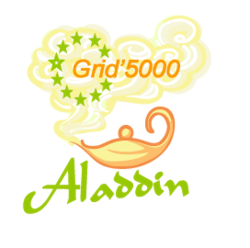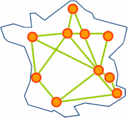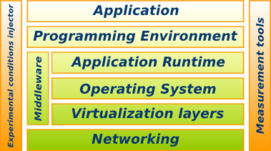Grid5000:Home
ALADDIN-G5K : ensuring the development of Grid'5000for the 2008-2012 periodAn infrastructure distributed in 9 sites around France, for research in large-scale parallel and distributed systems Engineers ensuring the development and day to day support of the infrastructure are mostly provided by INRIA, under the ADT ALADDIN-G5K initiative. |
Latest newsGrid'5000 Spring School 2011 announced from April 18th to April 21stOrganized in Reims, from April 18th to April 21st 2011, this spring school will bring together, but is not limited to, Grid'5000's users, technical team and executive committee for 4 days of tutorials and talks focusing on best-practices and results. Presentations and practical sessions will cover both basic usage of the platform, for new users, or potential users of Grid'5000 and advanced and new usage of the platform, for current users. Latest updated experiment descriptions{{#experiments:3}} Latest updated publicationsFive random publications that benefited from Grid'5000 (at least 2928 overall):
Screencast of latest webUI developments availableA screencast demoing the latest developments in the user interface built on top of the API's is now available. These developments showcase in particular how the webUI can help you understand and aggregate the metrics of an experiment to help you check whether what is happening is what you are expecting. Remember that the API exposes all the data used by the webUI: you can build your own comparable tools. |
Grid'5000 at a glance
- Grid'5000 is a scientific instrument for the study of large scale parallel and distributed systems. It aims at providing a highly reconfigurable, controlable and monitorable experimental platform to its users. The initial aim (circa 2003) was to reach 5000 processors in the platform. It has been reframed at 5000 cores, and was reached during winter 2008-2009.
- The infrastructure of Grid'5000 is geographically distributed on different sites hosting the instrument, initialy 9 in France. Porto Alegre, Brazil is now officially becoming the 10th site.
Sites:
- Grid'5000 is a research effort developping a large scale nation wide infrastructure for large scale parallel and distributed computing research.
- 17 laboratories are involved in France with the objective of providing the community a testbed allowing experiments in all the software layers between the network protocols up to the applications.
The current plans are to extend from the 9 initial sites each with 100 to a thousand PCs, connected by the RENATER Education and Research Network to a bigger platform including a few sites outside France not necessarily connected through a dedicated network connection. Sites in Brazil and Luxembourg should join shortly.
All sites in France are connected to RENATER with a 10Gb/s link.
This high collaborative research effort is funded by INRIA, CNRS, the Universities of all sites and some regional councils.
Initial Rationale
The foundations of Grid'5000 have emerged from a thorough analysis and numerous discussions about methodologies used for scientific research in the Grid domain. A report presents the rationale for Grid'5000.
In addition to theory, simulators and emulators, there is a strong need for large scale testbeds where real life experimental conditions hold. The size of Grid'5000, in terms of number of sites and number of processors per site, was established according to the scale of the experiments and the number of researchers involved in the project.
Current funding
As from June 2008, INRIA is the main contributor to Grid'5000 funding.
INRIA |
CNRS |
UniversitiesUniversity Joseph Fourier, Grenoble |
Regional councilsAquitaine |





